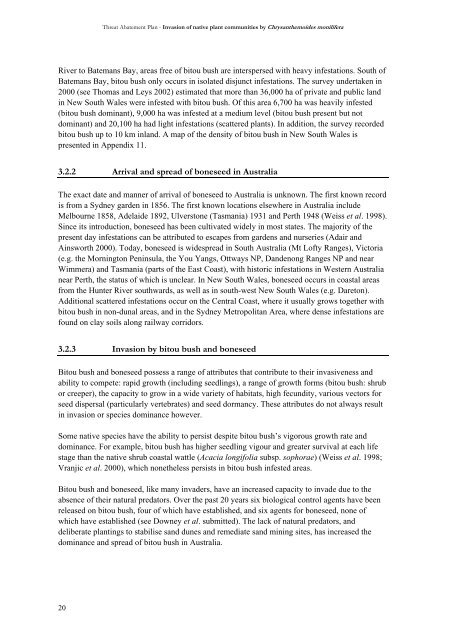NSW Bitou Bush Threat Abatement Plan - Department of ...
NSW Bitou Bush Threat Abatement Plan - Department of ...
NSW Bitou Bush Threat Abatement Plan - Department of ...
You also want an ePaper? Increase the reach of your titles
YUMPU automatically turns print PDFs into web optimized ePapers that Google loves.
20<br />
<strong>Threat</strong> <strong>Abatement</strong> <strong>Plan</strong> - Invasion <strong>of</strong> native plant communities by Chrysanthemoides monilifera<br />
River to Batemans Bay, areas free <strong>of</strong> bitou bush are interspersed with heavy infestations. South <strong>of</strong><br />
Batemans Bay, bitou bush only occurs in isolated disjunct infestations. The survey undertaken in<br />
2000 (see Thomas and Leys 2002) estimated that more than 36,000 ha <strong>of</strong> private and public land<br />
in New South Wales were infested with bitou bush. Of this area 6,700 ha was heavily infested<br />
(bitou bush dominant), 9,000 ha was infested at a medium level (bitou bush present but not<br />
dominant) and 20,100 ha had light infestations (scattered plants). In addition, the survey recorded<br />
bitou bush up to 10 km inland. A map <strong>of</strong> the density <strong>of</strong> bitou bush in New South Wales is<br />
presented in Appendix 11.<br />
3.2.2 Arrival and spread <strong>of</strong> boneseed in Australia<br />
The exact date and manner <strong>of</strong> arrival <strong>of</strong> boneseed to Australia is unknown. The first known record<br />
is from a Sydney garden in 1856. The first known locations elsewhere in Australia include<br />
Melbourne 1858, Adelaide 1892, Ulverstone (Tasmania) 1931 and Perth 1948 (Weiss et al. 1998).<br />
Since its introduction, boneseed has been cultivated widely in most states. The majority <strong>of</strong> the<br />
present day infestations can be attributed to escapes from gardens and nurseries (Adair and<br />
Ainsworth 2000). Today, boneseed is widespread in South Australia (Mt L<strong>of</strong>ty Ranges), Victoria<br />
(e.g. the Mornington Peninsula, the You Yangs, Ottways NP, Dandenong Ranges NP and near<br />
Wimmera) and Tasmania (parts <strong>of</strong> the East Coast), with historic infestations in Western Australia<br />
near Perth, the status <strong>of</strong> which is unclear. In New South Wales, boneseed occurs in coastal areas<br />
from the Hunter River southwards, as well as in south-west New South Wales (e.g. Dareton).<br />
Additional scattered infestations occur on the Central Coast, where it usually grows together with<br />
bitou bush in non-dunal areas, and in the Sydney Metropolitan Area, where dense infestations are<br />
found on clay soils along railway corridors.<br />
3.2.3 Invasion by bitou bush and boneseed<br />
<strong>Bitou</strong> bush and boneseed possess a range <strong>of</strong> attributes that contribute to their invasiveness and<br />
ability to compete: rapid growth (including seedlings), a range <strong>of</strong> growth forms (bitou bush: shrub<br />
or creeper), the capacity to grow in a wide variety <strong>of</strong> habitats, high fecundity, various vectors for<br />
seed dispersal (particularly vertebrates) and seed dormancy. These attributes do not always result<br />
in invasion or species dominance however.<br />
Some native species have the ability to persist despite bitou bush’s vigorous growth rate and<br />
dominance. For example, bitou bush has higher seedling vigour and greater survival at each life<br />
stage than the native shrub coastal wattle (Acacia longifolia subsp. sophorae) (Weiss et al. 1998;<br />
Vranjic et al. 2000), which nonetheless persists in bitou bush infested areas.<br />
<strong>Bitou</strong> bush and boneseed, like many invaders, have an increased capacity to invade due to the<br />
absence <strong>of</strong> their natural predators. Over the past 20 years six biological control agents have been<br />
released on bitou bush, four <strong>of</strong> which have established, and six agents for boneseed, none <strong>of</strong><br />
which have established (see Downey et al. submitted). The lack <strong>of</strong> natural predators, and<br />
deliberate plantings to stabilise sand dunes and remediate sand mining sites, has increased the<br />
dominance and spread <strong>of</strong> bitou bush in Australia.
















